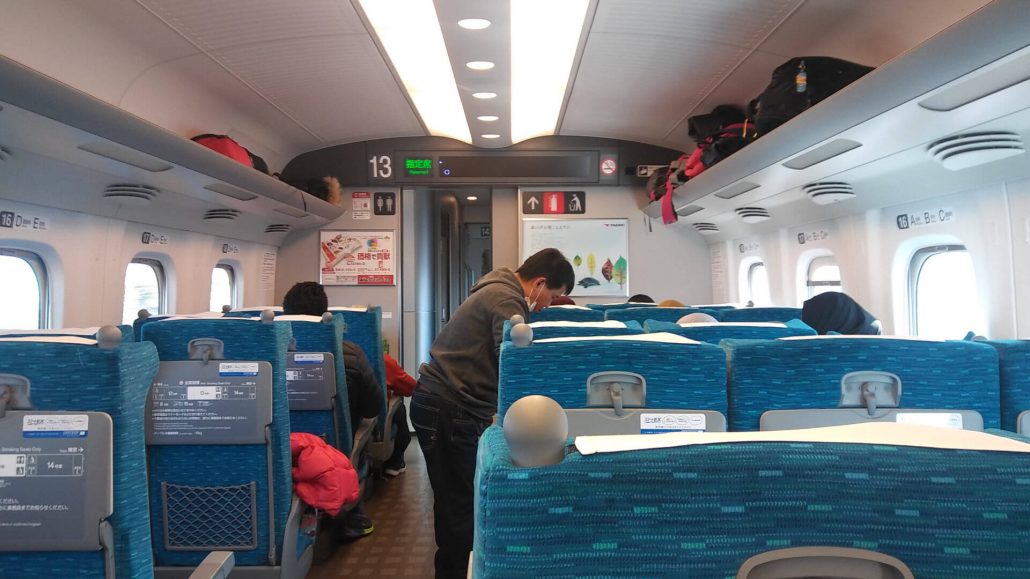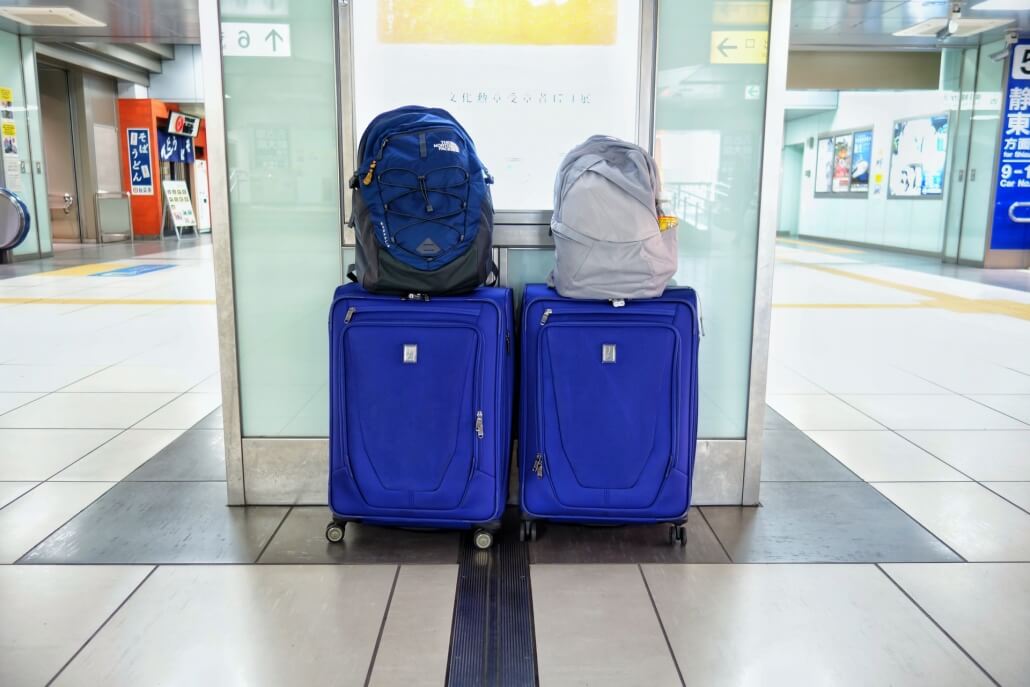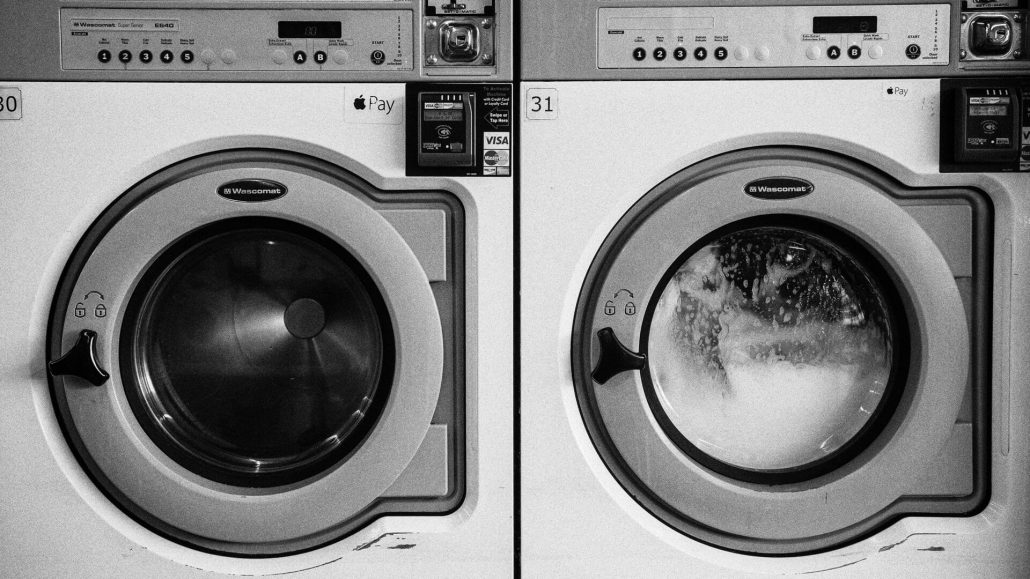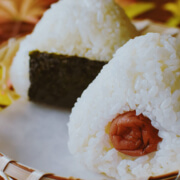Tips for Packing Light
When packing for your trip to Japan, it is very important to follow these tips for packing light. Packing light doesn’t just refer to weight, it also means keeping the number of bags to a minimum.
CONTENTS
3 Reasons for Packing Light When Visiting Japan
1. You will do quite a bit of traveling within Japan
Japan is small, but it is not small enough to do only day trips from Tokyo. So it is very likely that you will be traveling from city to city by train. This can be very cumbersome if you have two large suitcases, a small carry-on suitcase and a backpack.
Not only will it be difficult to navigate the crowded train stations, it will also be difficult to store all of your suitcases on the train. You must keep in mind that more than 20,000,000 tourists visit Japan each year, so you won’t be the only passenger dealing with suitcases on a train.
The main luggage storage area on trains in Japan is above the seats. This means you will want to keep the number of suitcases to a minimum. You will also want them to be as light as possible, so you will be able to lift them over your head and onto the overhead storage.
2. Elevators and escalators are not always available
Over the years Japan has gone to great lengths to install escalators and elevators at most train and subway entrances, but I personally would not count on them.
There will be occasions where you will need to pick your suitcase up and walk either up or down a flight, or two, of stairs. This task is only compounded if you have too many suitcases, or they are too heavy to lift.
3. Hotel rooms can be small
Hotel rooms in Japan can be as small as 118 square feet. It’s usually just enough room for a bed, a desk and the bathroom. Luggage is an afterthought. Imagine a small bedroom with a bathroom in it and no closet. Japan is small, cities are tight and this all trickles down to hotels.
However, not all hotel rooms in Japan are small. On our Japan Tours we work hard at booking hotel rooms that meet our level of standards for size, cleanliness and comfort.
Tips for Packing Light
Take only what you need
I recommend bringing one large, airline compliant, suitcase and a normal-sized backpack. Below is a photo of our 25-inch TravelPro Spinner suitcases and our backpacks.
It’s important to have a suitcase with 4 wheels and a comfortable backpack. Having a suitcase with 4 wheels will make it easier to navigate Japan’s crowded train stations.
Packing this way will allow you to bring everything you will need for your trip, have a day pack while sightseeing and give you enough space for souvenirs to take home with you.
Things You Need to bring:
- Thick socks (with no holes) – You will be taking your shoes off a lot, and you don’t want to be embarrassed with a big hole in your sock.
- Rain jacket – You will be out in the elements, so a good rain jacket helps with wind and keeping you dry.
- Vitamins and medicines – Don’t expect to get prescriptions refilled in Japan and don’t assume they’ll have the supplements you take. Japan has very strict rules on prescription and over the counter drugs.
- Toothpaste – They have toothpaste, but they probably don’t have your brand.
- Deodorant – Again, they have some deodorant, but nothing like the selection we have at Target. All the time I lived in Japan, I either stocked up while in the US or had friends and family ship it to me.
- Good walking shoes, preferably ones that slip on and off easily – You will probably only bring one or two pairs of shoes, so try to buy your shoes a month in advance and break them in.
Things you don’t need to bring:
- Umbrella – It rains a lot in Japan and they are prepared. You can pick up a pretty decent umbrella for under 5 USD, so there is no point in packing one.
- Hair dryer – It is best to leave hair dryers at home because the heating element will not work properly in Japan. Most hotels provide hair dryers so this shouldn’t be a problem.
- Uncomfortable dress shoes – You will be doing a ton of walking, so just leave the dress shoes at home.
- Plug/power adapter – The voltage in Japan is 100V. Most electronics from North America (120V) will work in Japan, but you may find that most power outlets have only 2-prongs. If you have electronics with 3-prongs, you will probably need an adapter.
Bring 5 Days Worth of Clothes
Many hotels in Japan have coin laundry facilities, so you can plan on washing clothes every few days to save on luggage space.
Choose clothes with neutral colors so you can easily mix and match. I don’t recommend bringing outfits, because if you spill sauce on your pants or shirt you’ll loose a whole outfit rather than one item of clothing.
You can get more wears out of bottoms than tops, so consider swapping out a pair of pants for one or two more shirts. You’ll find that you go through socks and underwear the fastest, so pack a couple extra of each.
Shoes usually weigh a lot and take up the most space, so don’t bring more than two pair. Make sure that both are comfortable enough to walk a few miles. If you are going to buy new shoes, do so at least a month in advance and break them in before your trip.
Pack and Practice
I know this sounds crazy, but hear me out.
Pack your suitcase with everything you think you need to take with you. This includes all your toiletries, underwear, socks, shoes, etc,. Then put it all in your suitcase and go for a brisk walk around your neighborhood.
When you get back to your home, wheel your suitcase to a large closet, lift it up and put it on the top shelf. If you live in a two or three story house, walk up and down your stairs with your backpack on and carrying your suitcase.
If this was all super easy and you had no trouble at all, you packed well. However if your arm was getting slightly sore during your walk, you had to strain to lift the suitcase up onto the shelf or you had trouble walking up and down your stairs, then your suitcase may be too heavy.
Unless you’re a bodybuilder, the airline weight limit is not a goal you should set your sights on! Japan is a pedestrian focused country, where walking and public transportation is the norm. So you want your luggage to be easy to navigate, carry and lift over your head.
Want a Unique Japan Trip?
Discover Japan planning secrets with our best selling Itinerary Planning Course. Or inquire about our exclusive Small Group Tours.
I Needed That
My advice for packing light is to really step back and think about what you want to take and what you need to take. If once you get to Japan you find that you should’ve packed that extra shirt or pair of pants, you’ll find that they have some great Japanese and American clothing stores.
Disclaimer: There are affiliate links in this article. This means that if you make a purchase after clicking on these links, we may receive a small commission at no extra cost to you. We have no association with the companies or the products reviewed. These are our own opinions of top travel products.






 Pixabay
Pixabay  @JAPANandmore
@JAPANandmore  @JAPANandmore
@JAPANandmore 
 Wiki
Wiki  @JAPANandmore
@JAPANandmore 




 ©JAPAN and more
©JAPAN and more ©JAPAN and more
©JAPAN and more